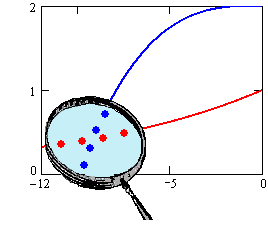
Representations & Methods

The last example helps us to appreciate some of the limitations of both algebraic and graphical methods.
Graphical methods usually involve a certain amount of trial and error, and they may leave some doubt as to whether we have looked closely enough at all of the right parts of the graph. Even the solutions we do find may be limited in their accuracy by the resolution of our graphing calculators and computers. (Not to mention the limitations of the model itself.)
We can never expect graphical solutions to be exact in the same way that algebraic solutions are exact. When algebraic solutions are not an option, the best that we can hope for is a method that will successively improve on the accuracy of our estimates. This is what one does when "zooming in" on a calculator or computer. Unfortunately, this method reaches its limit when the technology does. It eventually becomes impossible to improve on the accuracy of the graphical solutions by zooming.
Numerical methods, on the other hand, provide systematic procedures by which we may obtain arbitrarily better numerical estimates.
Numerical methods are algorithmic, in the sense that they provide a definite sequence of steps to follow, and they are usually iterative, which means that a few relatively simple steps are repeated over and over again to obtain the successively better estimates. Like graphical methods, numerical methods involve a certain amount of trial and error; but the "trials" of numerical methods are carefully controlled, and the errors are then systematically reduced.
The next example returns to the capybara problem, and gives a simple numerical method for finding a solution.
|
|
|
...to Example |
| Back to Contents | ||